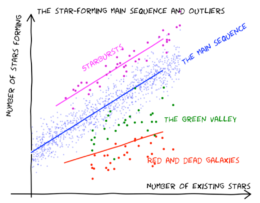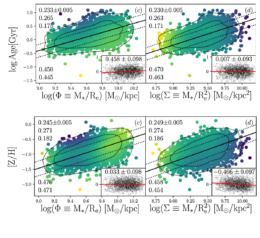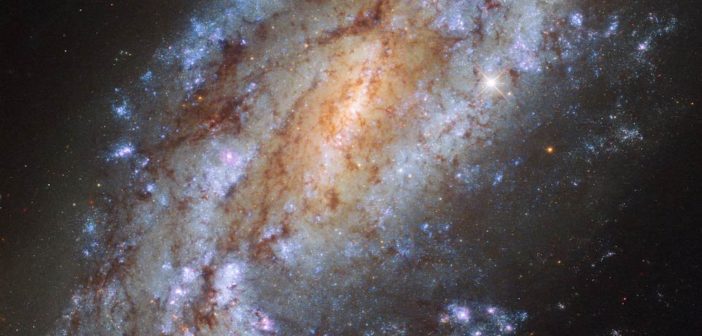A galaxy’s stars hold clues to its history. So, if we look at the stellar populations of several galaxies along with the properties of the galaxies themselves, we may be able to tease out trends in galaxy evolution.

The number of new stars formed versus the number of existing stars for different types of galaxies. Star-forming galaxies hang above the “main sequence”, with “starburst” galaxies lying at the extreme. [V. Buat]
Galaxies and the Stars that Make Them
To begin with, what stellar properties can you use to study galaxy evolution? Age is a key one. A stellar population with more old stars suggests that the galaxy formed most of its stars a long time ago, while a stellar population dominated by young stars points to more recent star formation.
The abundances of different elements are also insightful. Astronomers often consider the abundance of elements that aren’t hydrogen and helium relative to hydrogen (metallicity) and the abundance of alpha elements, like carbon and oxygen, relative to iron. The former property can tell us how many generations of stars the galaxy has hosted, and the latter can tell us how long the galaxy was forming stars.
As for galaxies themselves, the overall mass and size of a galaxy can be linked to the stars it holds. Another useful quantity is velocity dispersion, or how stars move within the galaxy. Recently, more subtle properties like the surface distribution of mass across a galaxy and its gravitational potential have been used as probes of galaxy evolution. In a new study, a group of researchers led by Tania Barone (The Australian National University/The University of Sydney) explored how these structural properties could be related to stellar properties.

Starting from the upper-left plot and moving clockwise: log of age versus gravitational potential, log of age versus surface mass density, metallicity versus surface mass density, and metallicity versus gravitational potential; best-fit relations are shown by the solid line. Galaxies plotted in yellow have a smaller radius than galaxies plotted in blue. The inset plots show the fit residuals, the difference between the measured and best-fit age/metallicity. If the slope of the residual distribution (given by the numbers in the inset) is small, it’s likely that the relation actually exists. Click to enlarge. [Adapted from Barone et al. 2020]
Tying Things Together
Barone and collaborators focused on star-forming galaxies in this study. While all galaxies could be said to be star-forming, a galaxy must be forming stars at a higher than average rate to be labeled a star-forming galaxy. This distinction is important since combining results from different types of galaxies could obscure any existing trends.
Age and elemental abundances can be calculated under different assumptions, one based on the brightness of the galaxy and the other based on the galaxy’s mass. However, Barone and collaborators found that under both of these assumptions, age appears to correlate with surface mass density and metallicity correlates with gravitational potential. Interestingly, both these relations were also seen in a similar study of early-type galaxies that formed when the universe was younger.
So what do these correlations say about galaxy evolution? The age–mass-density relation suggests that star formation is dictated by the availability and density of star-forming gas. The metallicity–gravitational-potential relation suggests that galaxies with lower potentials have a harder time keeping material from being whisked away by astronomical winds.
One way to explore these relations further — aside from observations — is using cosmological simulations. For now, this study is a great example of how we can assemble the clues we have to solve the puzzle of galaxy evolution!
Citation
“Gravitational Potential and Surface Density Drive Stellar Populations. II. Star-forming Galaxies,” Tania M. Barone et al 2020 ApJ 898 62. doi:10.3847/1538-4357/ab9951


2 Comments
Pingback: Związek między gwiazdami i ich galaktykami – PTMA Kraków
Pingback: Związek między gwiazdami i ich galaktykami – Astronomia Śląska